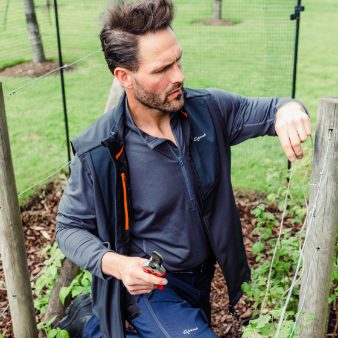November - the slow-down month

I find it very comforting now that the days are shorter and the air is much cooler. As if it’s time for hibernation! Somehow that hot cup of tea after a day in the garden becomes more rewarding than ever... especially when my little spaniel Penny decides to sit on my feet for attention, unknowingly warming them up nicely and grounding me to the spot!
Two years ago, we talked about making some significant changes inside the walled garden. Finally, this year, we are going to put our plans into action. November is the perfect time to start any new projects. The ground is still warm and plants become dormant, which means we can move them without causing too much stress. Also, when planting new plants at this time of year, they stand a much better chance of survival. This is because there is not too much heat or sunshine to stress or dry out the ground beneath them.
On top of this project, there are lots of other jobs we need to be getting on with. I class this month as the beginning of putting the garden to bed and preparing it for the spring.
1- Cut back Hellebore leaves. Cutting off last year‘s foliage helps to prevent Hellebore leaf spot disease remaining on the leaves through winter. It also helps to see the flowers begin to emerge in late January early February. Simply cut away this year's leaves to the base, this will enable good airflow and light to the base of the plant. Make sure you dispose of any leaves that have started to turn black or look diseased.
2- Plant tulips. It’s very easy to treat tulip bulbs like any other bulbs. Don’t! Here’s why. The first rule of thumb is to wait until after the first frosts and the soil has cooled down, as this helps to prevent the disease tulip fire. In the UK the preferred window to plant tulips is usually mid November to the beginning of January. It’s extremely important to plant your tulips at least three times the depth of the bulb (at least 8”). I find the deeper you plant them the less chances the squirrels will dig them up!
3- Plant bare root roses. This has always been our preferred choice, because it’s cheaper, they become better acclimatised to your soil, and establish quicker in the spring. Before you consider buying a rose, I highly recommend you prepare the ground at least a couple of weeks beforehand. Then, when it comes to planting, the process is much easier and less stressful to the rose. When your rose arrives, soak the roots in a bucket of water for at least 2 hours prior to planting. Prepare the hole, then whilst holding the rose over the hole, sprinkle the roots with Mycorrhizal Fungi. Place the rose into the centre of the hole that should be no deeper than the roots. The base of the stems should be 2” below soil level. Placing a bamboo cane horizontally across the top of the hole can help determine this. Finally, water in well.
4- Lift and store Dahlias. There are different ways to go about this without making it too complicated or stressful. You can either, depending on how wet your ground becomes in the winter, lift and store your dahlia tubers or, If your ground does not become waterlogged and is fairly dry during the winter months, you can safely leave them in the ground. Just chop the stalk to the base after the first hard frost, and place a bucket full of compost or top dressing over it to insulate the crown during the winter months. If all of the above feels like too much hard work (and for goodness sake, don’t beat yourself up about this..It’s not worth it! ), then simply treat your dahlia tuber as an annual, by digging them up and replacing with new ones in the spring as they are an inexpensive purchase.
5- Begin top dressing beds and borders. We tend to do this once every two years, purely because it’s such a mammoth job here! Even though it’s a labour intensive job, and can be quite time-consuming, the outcome outweighs the effort. The reason for doing this during the autumn is because it helps to trap the moisture in the soil, helping young plants to establish and thrive. It also acts as a weed suppressant, which can make your life much easier during the summer months.
Finally, I’d like to say a very big thank you to Sue for inviting me to write ‘The Laundry Garden Year'. It’s been an absolute pleasure.







